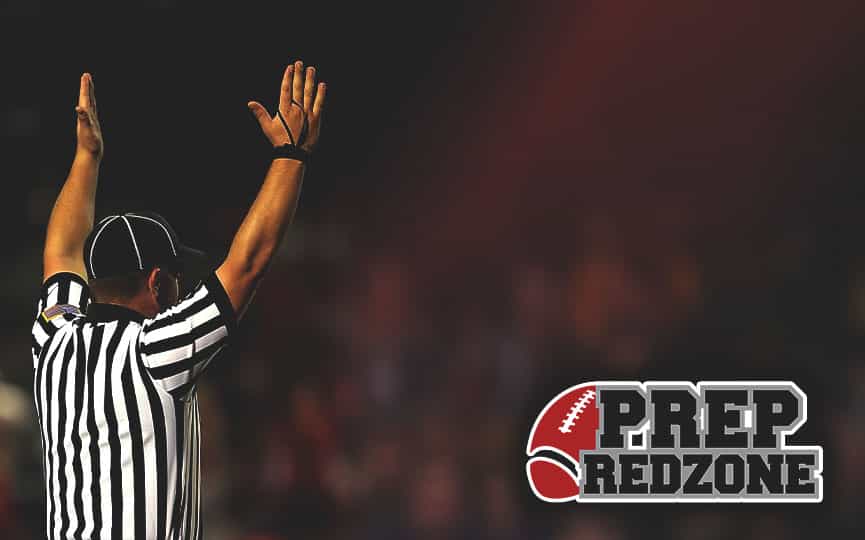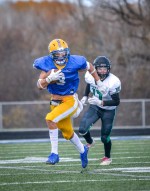Coaches Corner: Concussions & Player Safety
Player safety in football has been the one of the most highly debated topics in athletics for more than a decade. From Pop Warner to the National Football League, new rules, regulations and equipment have been integrated to help make the game safer.
Many of those initiatives have focused on lowering the amount of concussions in the game, largely because of academic research observing a link between Chronic Traumatic Encephalopathy (CTE) to repeated head trauma sustained playing football. While most of the CTE research has been limited to professional players, some studies have tried to determine the relationship between head trauma and long-term brain diseases in high school athletes.
The discussion has forced leaders to adapt to a new environment at the high school level. For the article below, NFN’s Brian Jerzak asked multiple head coaches around Minnesota to give their thoughts about concussion concerns, improving players’ safety, future safety initiatives, and addressing parents’ concerns about playing football. Here are their responses:
Mike Kesler – Rochester Lourdes
“We are all worried about player safety, and we need to keep that at the forefront as coaches. I do feel football is always the first sport that is brought up and that gets challenging.
Awareness has been the biggest improvement. A limited amount of contact during the summer and practice time during the season has helped. Less contact has helped keep guys safer during the season. Also, the emphasis on tackling and keeping the head out of the game has helped. Improvements in equipment have also helped and constant education of the coaches is critical. There is a lot of turnover with coaches, so we need to make sure new coaches are up to speed, and current coaches have required education courses to stay on top of the changes.
The game as never been safer. With all the education and emphasis on safety, the game is much improved.”
Clay Anderson – Pipestone Area
“I am always amazed at the focus on the dangers of football when 5,000 teenagers die each year* from texting and driving – seems like they would make a movie about that first.
I like the new rules on peel-back blocks, and I love how we emphasize safer tackling now. I think we tackle better now, because we have to practice so much on doing it correctly. I also think we really have come a long way with our equipment.
Altogether, our game is safer now than it has ever been. I also like the increased knowledge that we have on “return to play” policies. I like the concussion testing we do in the preseason, which greatly helps us to determine concussions and lets us know when our athletes are fully healed and can return to play.”
The game has never been safer. I tell parents that we hardly ever hit in practice anymore which helps a lot. Then I ask them if they are never going to let their child drive.”
*Editor’s note: 3,477 people were killed by distracted drivers in 2015.
Bubba Sullivan – Northfield
“I am concerned about the safety issues in the sport. There is a degree of risk in all sports and football tends to be on the higher end of that continuum. However, the physical benefits from being active, the critical life lessons about teamwork, dedication, working toward a cause greater than ourselves, etc. that help our athletes be leaders and strong citizens later in life are worth it.
In many ways, the game is safer now than it has ever been. Rule changes are making the game safer, the way we coach technique has made the game safer. Our knowledge about concussions and return to play protocols have made the game safer. Equipment continues to be developed with player safety in mind.
We practice differently and have much less contact in practice. We must continue to look at what we do and how we play through the lens of safety. Continue to look at rules and parts of the game that we can make safer without losing the essence of the sport.”
Brian Vossen – Lakeville North
“Football is one of the safest sports an athlete can play. There is head to toe equipment, and every school is using state of the art helmets that have been designed to protect an athlete the best a helmet can. Any sport where contact can be made, and an athlete can hit their head on the turf, ice, gym, or mat can have concussions. Football is one of the few that equips its athletes with helmets. I am happy changes have been made to make this as safe a game as possible.
We have changed the way we practice. We have done away with full speed drills and have limited the number of live practices. Practice equipment has improved and allows us to practice tackling without using each other.
We have also changed the way we teach tackling. We no longer teach kids to lead with the forehead. We stress creating takeaways rather than big hits. In-game rule changes – like removing crack blocking or blindside blocks – and targeting rules have also made the game safer.
Football is a physical game. That is what makes it great. No other sport teaches a person how to get up after being knocked down both physically and mentally. Athletic trainers should not diagnose a concussion. I respect their right to believe an athlete may have one, but I believe a trained doctor should work with athletes to make sure they are safe to return. Most doctors actually return an athlete to play sooner due to the rarity that the injury is actually a concussion.
I give parents our concussion stats. At Lakeville North, we typically have one to three a year in grades 3-12. That is less than a one percent chance of getting a concussion. We can’t prevent any injuries 100 percent, but football has made a stronger effort than any other sport to help reduce the risk. Coaches are educated and understand the importance of treating concussions with the severity they deserve.”
Rex King – Simley
“My overall concern is that we are going soft as a country. Young men need football in their lives. They need to learn how to get knocked down and get back up for somebody else other than themselves.
Football has never been safer; however, the negative media attention is so skewed it’s disheartening. If the safety of young men was the real priority, then we would move the driving age from 16 to 18 or even 21. Young people driving in a car is far more dangerous than playing football.
The game is at its the safest point in history. Coaches have adapted and have done a wonderful job with amending their practices for player safety. There are risks in our game just as in life.
The greatest thing that could ever happen to our sport in its current state is having a doctor who would be willing to come out and say that the health risks of playing high school football are minimal. I’ve had numerous conversations with doctors who privately tell me that there are zero concerns with concussions for high school athletes. It’s when you get into the Division I or the pro level where it starts to take effect on the humans that are playing the sport.
If you’re worried about your child playing football because of the risk of injury you really need to take a look at what they are doing when they are not at school. Are they driving a car? Are they riding a bike or skateboard? Those three things are far more dangerous than playing the sport of football. It is my belief that every young man needs football in his life, so he can learn something about himself and develop some discipline and grit and other tools that he will carry on through the rest of his life.”
Johnny Benson – Kimball Area
“I do not believe that football has become any more dangerous or likely to cause an injury compared to any other time period. There’s no doubt that the safety issue has been forced to the spotlight now more than ever, but that doesn’t mean it is more of an issue than before.
When we sign our kids up to play a competitive, contact, sport, we know the risks. Athletes are putting their bodies on the lines, and football is no different than any other sport. Injuries are no fun – they’re my least favorite part of being involved with athletics. That being said, the positives of being a part of a team and competing in a high school sport with your friends for your school and community, in my opinion, outweigh the negatives or risks associated.
Football has come a long regarding safety – as have other sports as well. We’re always learning new information and finding new ways to prevent injuries, and this is a good thing for the game. Reducing contact in practice, the proper coaching of technique, weight training, and injury-prevention training have all helped athletes in general in combatting injuries.
We can always continue to improve. Let the experts and those with the knowledge provide the facts or information and take what they are telling us and put it into action.
I think that a parent should look at the consequences of playing football. Do the positives outweigh the negatives? I say yes, but that’s just me. Football is a beautiful game – the ultimate team game. The friendships gained, lessons learned, and experiences from playing high school football are tremendous in impact.”
Jared Essler – St. Michael Albertville
“I think these concerns should be taken seriously and we should do everything in our power as coaches, officials and administrators of the game to progress the game to a point that is as safe as possible.
I feel there has been a number of things that have progressed in the game for the better. First, the quality of helmets has improved in the last ten-plus years. Second, I believe most coaches are teaching safer progressions of blocking and tackling to minimize the sub-concussive hits in practice. I know we have changed the way we teach. Third, we have focused on training the neck, and trapezius muscles summer weight program because of the research connected to injury prevention of concussions by strengthening this area of the body. Lastly, I like the Minnesota State High School League’s summer practice restrictions implemented two summers ago. It gives the kids a chance to rest and recover, to be multi-sport athletes and to be hungry for the start of the season.
I think there are a lot of rules. The consistent enforcement of those rules by officials can be improved. Specifically, officiating in the kicking game needs improvement, and I also anticipate these rules to be changed in the future to continue to make the game safer.
There is a risk, benefit analysis that every parent and player should do when considering a sport. Right now, the benefits to football far outweigh the risks.”
Tim Carlson – Bloomington Jefferson
“I believe it’s good and bad. It has been good because I feel practice schedules and tackling techniques have improved over the last couple of years. This has really been good at the youth levels where USA Football has been a tremendous help.
I feel it’s bad because of the decline in numbers of kids playing football. To hear kids are quitting football to play soccer, which yearly has more concussions than football, is quite frustrating. Over the last several years our boys’ and girls’ basketball teams at Jefferson have had more concussions than football. We never read about that stuff though.
The push at youth levels to join USA Football and tackling equipment such as and tackle wheels have been a great help. Minnesota Football Coaches Association coming out with multiple articles on concussions have also been a great resource.
We need to keep working at the youth level. If kids play safe and limit the injuries there, they will tend to keep playing football.
We also work with moms at the high school level to try and keep them informed on football with our “Mom’s Chalk Talk” we do one night in the fall. We provide articles on concussions that as well as articles which talk about the risks of sports versus the benefits. Kids can get hurt in any sport or by just playing at the playground.”


















